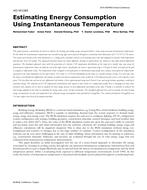Description
This paper presents a mechanism by which to estimate the heating and cooling energy consumed within a room using measured instantaneous temperature. In this work, the instantaneous temperature was recorded using eight sensors placed throughout a laboratory with dimensions of 6.7 X 9.9 X 2.8 meters. The sensors were located at the room boundaries, i.e., ceiling, walls, and floor, and one at the heating source vent and configured to measure both temperature and pressure every 14 seconds. The approach presented herein uses finite difference methods to approximate the solution to heat flow partial differential equations. The developed approach starts with the generation of a discrete 3-D temperature distribution of the room for a specific time step using the instantaneous temperature values recorded by each of the eight sensors. Specifically, the room is represented using a 3-D grid in which each point of the gird is assigned a temperature value. The temperature values assigned to each grid point are determined using steady state analysis based upon the temperatures measured at the room boundaries by the eight sensors. The result is a 3-D heat distribution of the room at a specific instance of time. For each time step, the room is sub-divided into differential sub-volumes in which each discrete temperature value, within the 3-D temperature grid, serves as the respective center point. The heat flow into and out of each differential sub-volume is then approximated using basic Fourier Law and energy balance equations, resulting in consumed energy. The collection of all 3-D temperature distributions with respect to time results in a temperature profile that is changing over time; thus, transient state analysis can be used to calculate the total energy increase in every differential sub-volume across time. Finally, it is possible to estimate the total energy supplied to the room by summing the energy values across all time increments. The developed approach was used to calculate the total heating energy consumed for one day and compared to the estimated energy consumption value provided by EnergyPlus. The estimate provided by EnergyPlus was 1.4 times higher than that of the proposed method.
Citation: 2018 Annual Conference, Houston, TX, Conference Papers
Product Details
- Published:
- 2018
- Number of Pages:
- 8
- Units of Measure:
- Dual
- File Size:
- 1 file , 1.9 MB
- Product Code(s):
- D-HO-18-C063




